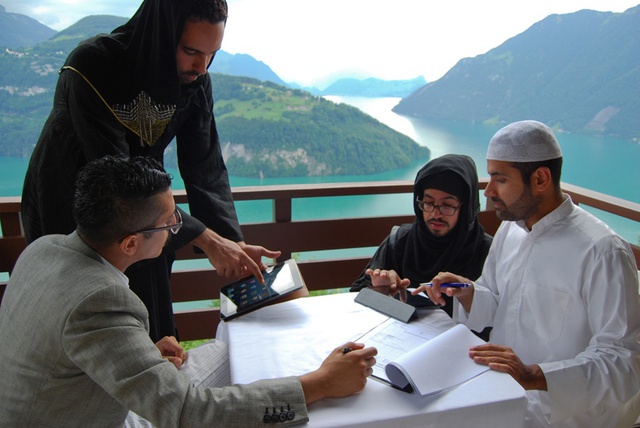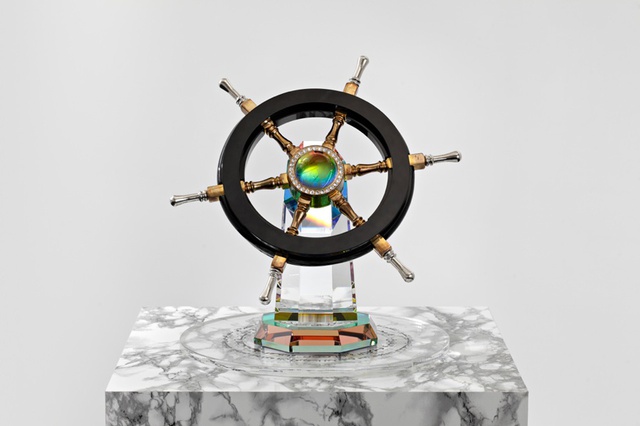Reviews
GCC: Achievements in Retrospective
GCC is a collective whose first US show at MoMA PS1 (of the Museum of Modern Art, New York), Achievements in Retrospective, is a satirical critique of the language and aesthetics of corporate governance. The collective – comprised of eight artists (formerly nine, with Sophia Al-Maria having left the group): Nanu Al-Hamad, Khalid Al Gharaballi, Abdullah Al-Mutairi, Fatima Al Qadiri, Monira Al Qadiri, Aziz Al Qatami, Barrak Alzaid and Amal Khalaf – describe themselves as a 'delegation'. Their take on collectivity operates as an artistic framework through which the group thinks through the terms of the original Gulf Corporation Council (GCC) and mimics them, thus replacing – or substituting – politics with art. The delegation meet at various 'global summits' resulting in the videos, photographs and installations they have exhibited at PS1. Borrowing linguistic cues from badly translated formal Arabic of the real GCC, their work draws from the rituals of government, corporate self-promotion and bureaucracy.
The entire exhibition is constructed as an elaborate parody. The first gallery is designed as a waiting room where a huge, wall-mounted flat screen television broadcasts the GCC manifesto. CGI images of skyscrapers amidst clouds, gulf waters and friendly businessmen is coupled with a voice-over claiming 'luxury is our goal', what exactly the video promotes is left unclear. The video mocks the sort of promotional materials that could be found at a hotel, airport, or exhibition centre, regaling the ideals of modernity and progress. Eight large clocks keep time from Mecca to Morschach, pushing the waiting room motif further.
The second gallery presents a variety of further formulations of this parodic corporate or governmental organization. A group of glossy photographs with the stage-managed slick of a press call document a series of monumental occasions – a handshake in front of a mountain backdrop, a high-level business meeting at a lodge – the Swiss Alps providing the perfect setting for these anodyne images. Hidden clues in the photographs further subvert the construction; look closely and you will find that the business meeting includes two of the bearded male artists masquerading in female attire.
Sequestered behind glass sits a reconstructed office of a lethargic, uninterested worker, replete with unfiled paperwork, decorated tissue boxes, and a few glass trophies. This back office, which is glimpsed only through small unfrosted glass panes, lets us in on the joke in which the high-tech future promised in the waiting room of the previous gallery is rarely realized. The work reads as a criticism of the employment policies of many of the GCC states, where citizens are rewarded with civil service jobs, creating a nation of inefficient bureaucratic structures. Further into the gallery a replica hexagonal conference table, beautifully constructed in miniature, cleverly minimizes the decisions made around the original where the GCC members unite.
Displayed atop a fake marble wall, glass and crystal trophies regale the achievements of the GCC to date. While only created in 2013 at Art Dubai, a summit of sorts, the GCC have already exhibited in Beijing, Berlin, Kassel, Kuwait, and London and have duly rewarded themselves for their phenomenal successes. The self-congratulatory awards in the strange forms of a boat steering wheel and an oyster shell amongst others, feature wordy, nonsensical declarations of pride. Based on ready-made awards easily purchasable in Kuwait City, the kind that might be given out to the unproductive bureaucrat in the frosted glass office nearby, the awards are empty, pointless and costly. With no sense of from where and whence they came, the objects highlight the grandiose self-importance of both big business and political summits where, in all likelihood, few achievements are actually reached.
By appropriating the opaque language and glossy aesthetics of corporate entities, the GCC make apparent the vacuous theatricality of diplomacy and the simulacra of the corporate and political in works that are at once subtle and brash. Devoid of meaning yet full of humour, the collective have produced an exhibition modelled on the facade of success, with small glimpses at the complete disconnect between the language of futurism and a dull, hollow everyday reality. Their works draws from the specific aspirations of the contemporary Gulf, yet also satirizes a very universal pomp and circumstance.
The practice of the GCC rests on a critique of the neoliberal relationships between business and government, yet their epic rise over the past year – this show comes just one year after they were formed – is borne out of those same structures. Achievements in Retrospective is an absurd joke that sends up the self-aggrandizing spectacles of power, many of those congratulatory and celebratory practices are rampant in the art world itself. Indeed, the parodic practice of the GCC collective leaves us wondering exactly who they are poking fun at, the annals of political power or an art world that has fallen for their antics so swiftly.
GCC: Achievements in Retrospective is on view at MOMA PS1 until 7 September 2014.

















